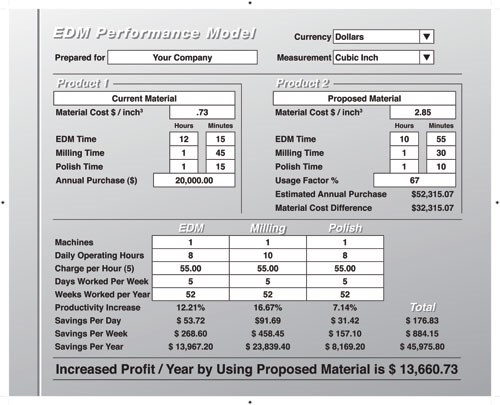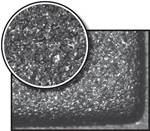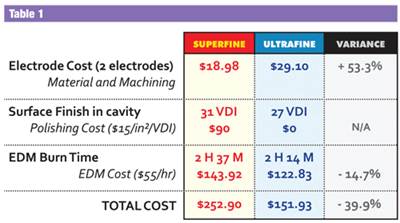Total Cost of Ownership and Productivity Analysis for EDM, Part 2
An actual application and comparison of the cost effectiveness of two different electrode materials.
In part one of this article, we examined a means to gauge the effectiveness of a company’s EDM operation and provided an introduction to a tool available to shop owners to measure the total cost associated within this area. The Total Cost of Ownership (TCO) model allows a quick and simple overview to fully ascertain the effect of the electrode material on the efficiency and profitability of various aspects in the EDM process. This segment will examine a model of an actual application and compare the cost effectiveness of two different electrode materials.
The TCO model can be used in two ways. The first would be as an estimation model. This method allows the input of data derived from several resources available that indicate an estimation of EDM performances at varying machine parameters. One point to keep in mind with this method is that the grade of electrode material used for the testing to gather this data may or may not be the same material currently in use on the shop floor. In this regard, the output of the data could be skewed and therefore may not reflect the most accurate estimation.
The second and most exact approach to the accuracy of the TCO model would be to record the performance of a controlled test or an actual EDM application. This bypasses any estimation of performance and assesses the true data input on the performance actually experienced. Figure 1 illustrates the TCO model of an actual EDM application where a company using one type of electrode material evaluated a material considered to be more applicable. Initially, resistance was met in this move as the recommended material was found to be at a considerably higher cost.
After much deliberation, the decision was made to record the performance variances of these two materials in order to determine future profitability of this application. As can be seen in this instance, the use of the more applicable material actually reduced the total operational costs and ultimately resulted in a cost savings even though the cost of the proposed electrode material was higher than the material currently being used.
Material Structure
Productivity can be reduced in a number of ways if the electrode material used in the EDM application is not optimized to the application. This reduction in productivity includes unstable cutting speed that extends the time of the EDM burn, the inability to produce desired surface finishes efficiently and increased potential of scrapping a part due to out of spec tolerances and pitting in the cavity. The characteristics of the electrode material also affect other shop operations or cost centers, such as the electrode fabrication or mold polishing areas. With increased electrode wear, additional electrodes or excessive electrode redressing may be required that increases production costs not to mention added requirements for cutting tools.
As illustrated in Figure 1, the use of high-performance electrode materials increases profitability by decreasing time spent on electrode fabrication, EDM machining or polishing. Shops that only consider the cost of the graphite alone, rather than the total production costs associated with the job may actually be losing money because they are not optimizing the material to the application and taking advantages of maximized efficiencies.
The ability to achieve maximized efficiencies in an EDM application is facilitated by the microstructure of the electrode material in use. Consistency in the material structure is paramount to minimize efficiency losses due to difficulties in the EDM cut. Materials with an inconsistent structure will have varying uniformity in regard to particle size and porosity.
This causes the adaptive control technology of the EDM machine to continually adjust itself to overcome issues with flushing and keeping the gap clear of contamination. Each correction of the adaptive control results in reduced efficiencies of the EDM process. Excessive correction is generally an indicator of instability in the burn and is often rectified with consistent materials. This lessens the requirements of the EDM sinker to continually alter the program in order to stabilize the burn and allows the sinker to perform at much higher efficiencies.
Benchmark Comparison
In this actual case, the shop owner was assertive enough to see that performance advantages may not occur with the most economical material. This testing showed that the EDM equipment was not being utilized to its fullest capacity. The audit showed that one of the most critical elements of operating EDM equipment is the electrode material because the material’s performance affects the productivity of each job and the capacity of the shop. Each equipment manufacturer publishes data that show typical EDM performances for specific machine settings, work metal and electrode materials when EDMing under optimum conditions.
With the TCO model, one can use the same parameters and measure the actual EDM performance to compare how close the machine is performing to the benchmark. If the operation cannot achieve the benchmark numbers then the shop may have slower production cycles than other competitive shops. Using this benchmark data combined with actual machine performance will indicate if the current capacity of the machine has been reached. If the current machine is not reaching the benchmarked production stated by the manufacturer, then productivity gains may often be realized by moving to a higher performing electrode material. These benchmark settings could be related to speed, wear or finish, depending on the requirements of the work performed in the shop.
Regardless if an estimation or actual data is used for the TCO model, shop owners must at some point review their EDM operations in order to fully determine if the equipment is running to full capacity and the EDM process has been optimized to provide maximum efficiency and profitability. The time spent conducting a TCO audit often discovers areas where significant process improvements can be achieved and increased competitiveness is realized.
Related Content
Hands-on Workshop Teaches Mold Maintenance Process
Intensive workshop teaches the process of mold maintenance to help put an end to the firefighting culture of many toolrooms.
Read MoreThe Benefits of Hand Scraping
Accuracy and flatness are two benefits of hand scraping that help improve machine loop stiffness, workpiece surface finish and component geometry.
Read MoreFundamentals of Designing the Optimal Cooling System
The right mold components can help improve mold cooling and thereby produce higher-quality parts.
Read MoreHow to Eliminate Chatter
Here are techniques commonly used to combat chatter and guidelines to establish a foundation for optimizing the moldmaking process.
Read MoreRead Next
Electrode Material Effect on CNC EDM, Part 1
When all the factors of the EDM process are taken into consideration, savings on the electrode material cost can result in a much larger overall cost.
Read MoreElectrode Material effect On CNC EDM, Part 2
A discussion of the reasons why the use of more, economical electrode material is not always the most cost-efficient means of CNC EDM
Read MoreAre You a Moldmaker Considering 3D Printing? Consider the 3D Printing Workshop at NPE2024
Presentations will cover 3D printing for mold tooling, material innovation, product development, bridge production and full-scale, high-volume additive manufacturing.
Read More












.jpg;maxWidth=300;quality=90)










